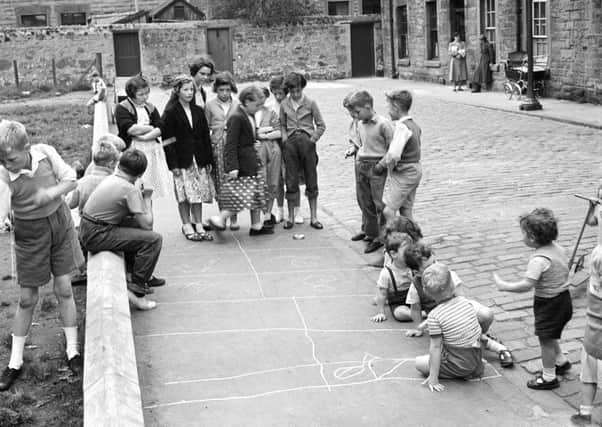Return to Reformation? Ban on kids’ chalk drawings is sign of times – Martyn McLaughlin


Save for the odd inclement day that has dared intrude on an uncharacteristically pleasant Scottish spring, the pavement running alongside our front garden has undergone numerous redesigns over the past few weeks.
Specks of green and purple and zig-zags of blue, orange, and red hues vie for space, though the dominant theme is a dazzling pink, realised in squiggling forms of various sizes. Close one eye and you can make out unicorns, trolls, aliens, princesses, and any other number of characters who inhabit the imaginations of the artists responsible.
Advertisement
Hide AdAdvertisement
Hide AdThe scrawls lend an otherwise non-descript strip of concrete a vibrancy, and extend a greeting that is far warmer and more personal than any novelty welcome mat. When the weather turns, the budding expressionists retreat indoors to plot their next masterpieces.
Sadly, there are parts of the country where rain is not required to dampen such ebullient spirits. In one Mactaggart & Mickel housing development, the humble chalk drawing is viewed not an attraction, but a scourge to be wiped clean.
In an episode which gives succour to those fearful that 21st century Scotland is in danger of becoming a brighter, more optimistic place, residents of the estate in the East Dunbartonshire town of Bishopbriggs were served with a letter chastising parents for allowing their youngsters to scrawl on the ground.
The daubings for hopscotch grids, the missive decreed, detracted from the overall appearance of the area. Worse was yet to come. “I would ask if these children belong to your family they refrain from this practice immediately,” the letter insisted.
Remarkably, the correspondence was written not by an officious neighbour with too much time on their hands, but a private company which maintains the estate’s communal areas.
Given the factoring firm in question, Speirs Gumley, sounds like a minor actor in the Reformation, the issuance of such a dour prohibition may well have been an act of nominative determinism. It is certainly difficult to conceive of any other reason for making such a preposterous demand.
It is the very presence of children in our streets, closes, and lanes that galvanises social bonds between generations and fosters a sense of community. Smart, child-centred urban planning can make a difference, but if the children themselves are made to feel unwelcome in such environments, what is the point?
The use of residential streets as playspaces is even more important in light of the gradual creep which has seen spaces that were once shared and free at the point of access colonised for private profit.
Advertisement
Hide AdAdvertisement
Hide AdIn Scotland’s biggest city, swathes of the most popular parks – a legacy of Glasgow’s great Victorian philanthropists – will be rendered off-limits for days at a time this summer in order to make way for music festivals and pop-up gigs.
It would verge on Speirs Gumley levels of curmudgeonliness to deny the positive impact such events have on the city’s cultural life, but equally, it would be remiss not to question why communal spaces are chosen for so many paid-for events.
It is crucial to ensure children are able to play freely in such environments and that their play itself is not stymied.
A cursory internet search shows that the absurd clampdown on chalk drawings has played out in countless towns in the cities the world over, with police even called in the most extreme examples to lecture youngsters about causing criminal damage.
To describe this as overzealous would be an understatement, but it also smacks of a complete failure to appreciate the importance of mark-making at a formative age.
It does not take an expert in children’s cognitive development to realise how drawing and painting not only bolsters communication skills, but allows youngsters to express themselves and perceive the world around them. If their canvas happens to be a pristine yet sterile new housing development, all the better.
Unlike other bumptious offenders, Speirs Gumley at least had the common sense to apologise promptly and overturn the chalk ban after a backlash from parents and residents’ groups. The embarrassment the company brought on itself ought to be punishment enough, but perhaps simply dismissing the episode as a one-off is too complacent a course of action; perhaps sterner action is required in order to guard against future outbreaks of meddling behaviour which treats children as second-class citizens.
For years now, adults aggrieved at anti-social behaviour in their communities have been advised to telephone Police Scotland’s 101 non-emergency number.
Advertisement
Hide AdAdvertisement
Hide AdIs it not time for the nation’s children be given a similar avenue of redress against the tutting, groaning, net-curtain twitching army of malcontents who treat them with contempt and derision?
The calls would be relayed to crack warden teams around the country, who would arrive at the scene with haste and ensure the protection of a child’s right to scribble on a pavement, ride their bike on a main road, or heaven forfend, blooter a size 5 Mitre off a lock-up door.
Any adults found to have lodged a gratitious grievance over such play would be forced to carry out child-centred stints of community service, erecting Swingball sets on every street corner and forfeiting their overgarments on request so that they might be repurposed as goalposts.
